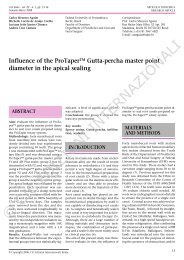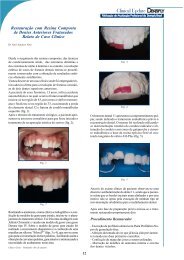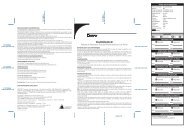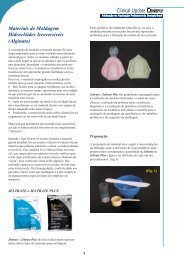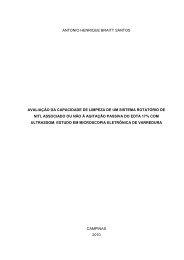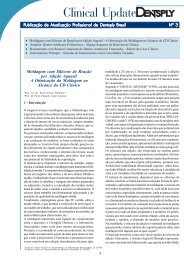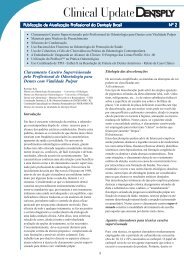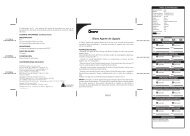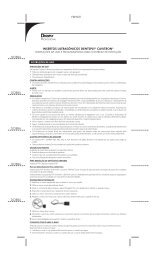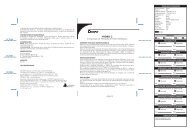Create successful ePaper yourself
Turn your PDF publications into a flip-book with our unique Google optimized e-Paper software.
Rosales-Leal<br />
Fig 1 Percentage of cases with each<br />
microlekage grade on the occlusal wall<br />
(O) and on the gingival wall (G) after<br />
24-h water immersion (24 h) and<br />
4000 cycles of thermocycling (4000<br />
c). Columns with the same letter are<br />
statistically similar (p > 0.05).<br />
bevel) were prepared with diamond-coated #330 burs at<br />
high speed under water cooling. Cavities were filled following<br />
manufacturer’s directions for use. The filling material<br />
was placed in two increments. The LED unit SmartLite PS<br />
(<strong>Dentsply</strong> DeTrey; Konstanz, Germany) (light output: 830<br />
mW/cm 2 ) was used for polymerization. The restoration was<br />
finished and polished with abrasive disks. Restored teeth<br />
were divided into two subgroups. In one group, teeth were<br />
kept in water at 37°C for 24 h. In the other group, teeth were<br />
thermocycled 4000 times between water baths at 5°C and<br />
55°C with a dwell time in each bath of 30 s. After sealing the<br />
roots with IRM (<strong>Dentsply</strong> DeTrey), the teeth were covered with<br />
two coats of nail varnish, leaving a 1-mm varnish-free margin<br />
around the restoration. Specimens were then immersed<br />
in a 0.5% water solution of basic fuchsin for 24 h and rinsed<br />
for 5 min with water. After this, specimens were embedded<br />
in acrylic resin, and 3 buccolingual slices of 1 mm thickness<br />
were obtained from each specimen (15 slices resulting in 30<br />
margins in dentin and enamel, per adhesive and aging condition).<br />
Slices were coded and randomly examined independently<br />
under the microscope in a blinded fashion. The<br />
grade of microleakage at occlusal and gingival walls was categorized<br />
as follows: 0: hermetic seal, no leakage; 1: mild microleakage,<br />
dye on no more than half of the wall; 2: moderate<br />
microleakage, dye on more than half of the wall but not<br />
including the axial wall; 3: massive microleakage, dye on the<br />
entire wall, including the axial wall. Data obtained represent<br />
the percentage of each leakage score in all the analyzed<br />
slices. Dentin permeability was evaluated as negative (absence<br />
of dye solution in dentin tissue) or positive (presence<br />
of dye solution in dentin tissue). Microleakage analysis was<br />
performed with the nonparametric Kruskal-Wallis H-test and<br />
Mann-Whitney U-test (p < 0.05). Fisher’s Exact test was used<br />
to evaluate dentin permeability (p < 0.05).<br />
RESULTS<br />
Figures 1 and 2 show the microleakage and dentin permeability<br />
data. The occlusal wall exhibited less leakage than the<br />
gingival wall. Etch-and-rinse adhesives achieved hermetic<br />
occlusal sealing, while self-etching adhesives showed slight<br />
occlusal leakage. Occlusal dentin permeability was negative<br />
for all the adhesives tested. Thermocycling did not affect the<br />
occlusal sealing.<br />
On the gingival wall, XNO and CLF obtained the lowest<br />
leakage, followed by XPB, SBX, and P&B, while SYN and IBO<br />
showed the highest leakage. Thermocycling did not affect<br />
marginal seal in dentin for XPB and SBX, with the latter<br />
showing more leakage after thermocycling compared to<br />
XPB. However, marginal seal of P&B, SYN, XNO, IBO, and CLF<br />
was influenced by thermocycling. Dentin permeability was<br />
negative for XPB, XNO, IBO and CLF. Positive dentin permeability<br />
was observed when P&B, SBX or SYN were used. Thermocycling<br />
increased the dentin positive permeability of P&B<br />
and SYN groups.<br />
DISCUSSION<br />
This in-vitro test provoked microleakage for all adhesives<br />
used. Three main factors could affect the sealing. One factor<br />
is the composite polymerization shrinkage that induces<br />
stress at the bonding interface. 8 This stress can potentially<br />
Vol 9, Supplement 2, 2007 257



